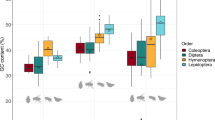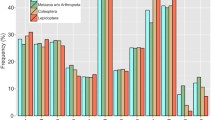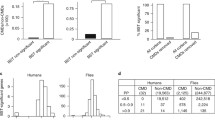Abstract
Synonymous codon usage bias is determined by a combination of mutational biases, selection at the level of translation, and genetic drift. In a study of mtDNA in insects, we analyzed patterns of codon usage across a phylogeny of 88 insect species spanning 12 orders. We employed a likelihood-based method for estimating levels of codon bias and determining major codon preference that removes the possible effects of genome nucleotide composition bias. Three questions are addressed: (1) How variable are codon bias levels across the phylogeny? (2) How variable are major codon preferences? and (3) Are there phylogenetic constraints on codon bias or preference? There is high variation in the level of codon bias values among the 88 taxa, but few readily apparent phylogenetic patterns. Bias level shifts within the lepidopteran genus Papilio are most likely a result of population size effects. Shifts in major codon preference occur across the tree in all of the amino acids in which there was bias of some level. The vast majority of changes involves double-preference models, however, and shifts between single preferred codons within orders occur only 11 times. These shifts among codons in double-preference models are phylogenetically conservative.




Similar content being viewed by others
References
H Akashi (1994) ArticleTitleSynonymous codon usage in Drosophila melanogaster: Natural selection and translational accuracy. Genetics 136 927–935 Occurrence Handle1:CAS:528:DyaK2MXpsFaq Occurrence Handle8005445
H Akashi (1995) ArticleTitleInferring weak selection from patterns of polymorphism and divergence at ‘silent’ sites in Drosophila DNA. Genetics 139 1067–1076 Occurrence Handle1:CAS:528:DyaK28XhsFWgtL0%3D Occurrence Handle7713409
H Akashi (1997) ArticleTitleCodon bias evolution in Drosophila: Population genetics of mutation-selection-drift. Gene 205 269–278 Occurrence Handle10.1016/S0378-1119(97)00400-9 Occurrence Handle1:CAS:528:DyaK1cXmtlWntg%3D%3D Occurrence Handle9461401
H Akashi S Schaeffer (1997) ArticleTitleNatural selection and the frequency distributions of “silent” DNA polymorphism in Drosophila. Genetics 146 295–307 Occurrence Handle1:CAS:528:DyaK2sXmsVarsbg%3D Occurrence Handle9136019
M Bulmer (1988) ArticleTitleAre codon usage patterns in unicellular organisms determined by selection-mutation balance. J Evol Biol 1 15–26
M Bulmer (1991) ArticleTitleThe selection-mutation-drift theory of synonymous codon usage. Genetics 129 897–907 Occurrence Handle1:CAS:528:DyaK38XhsVKhtL0%3D Occurrence Handle1752426
MS Caterino FAH Sperling (1999) ArticleTitlePapilio phylogeny based on mitochondrial cytochrome oxidase I and II genes. Mol Phylogenet Evol 1 122–137
MS Caterino S Cho FAH Sperling (2000) ArticleTitleThe current state of insect molecular systematics: A thriving Tower of Babel. Annu Rev Entomol 45 1–54 Occurrence Handle1:CAS:528:DC%2BD3cXisVequrg%3D Occurrence Handle10761569
DO Clary DR Wolstenholme (1985) ArticleTitleThe mitochondrial DNA molecule of Drosophila yakuba: Nucleotide sequence, gene organization and genetic code. J Mol Evol 22 252–271 Occurrence Handle1:CAS:528:DyaL28Xht1eqtb4%3D Occurrence Handle3001325
G D’Onofrio D Mouchiroud B Aissani C Gautier G Bernardi (1991) ArticleTitleCorrelations between the compositional properties of human genes, codon usage, and amino acid composition of proteins. J Mol Evol 32 504–510 Occurrence Handle1:CAS:528:DyaK3MXks1Grurg%3D Occurrence Handle1908021
M Dowton AD Austin N Dillon E Bartowsky (1997) ArticleTitleMolecular phylogeny of the apocritan wasps: The Proctotrupomorpha and Evaniomorpha. Syst Entomol 22 245–255
L Duret D Mouchiroud (1999) ArticleTitleExpression pattern and, surprisingly, gene length shape codon usage in Caenorhabditis, Drosophila, and Arabidopsis. Proc Natl Acad Sci USA 96 4482–4487 Occurrence Handle10.1073/pnas.96.8.4482 Occurrence Handle1:CAS:528:DyaK1MXjs1yls7Y%3D Occurrence Handle10200288
R Grantham C Gautier M Gouy M Jacobzone R Mercier (1981) ArticleTitleCodon catalog usage is a genome strategy modulated for gene expressivity. Nucleic Acids Res 10 7055–7074
. Ikemura (1982) ArticleTitleCorrelation between the abundance of yeast transfer RNAs and the occurrence of the respective codons in protein genes: Differences in synonymous codon choice patterns of yeast and Escherichia coli with reference to the abundance of isoaccepting transfer RNAs. J Mol Biol 158 573–597 Occurrence Handle1:CAS:528:DyaL38Xlt1Whur8%3D Occurrence Handle6750137
S Karlin J Mrazek (1996) ArticleTitleWhat drives codon choices in human genes? J Mol Biol 262 459–472 Occurrence Handle1:CAS:528:DyaK28XmtF2hurg%3D Occurrence Handle8893856
M Kreitman M Antezana (1999) The population and evolutionary genetics of codon bias. RS Singh CB Krimbas (Eds) Evolutionary genetics: From molecules to morphology. Cambridge University Press Cambridge 83–101
NP Kristensen (1997) ArticleTitleEarly evolution of the Lepidoptera plus Trichoptera lineage: Phylogeny and the ecological scenario. Mem Mus Natl Hist Nat 173 253–271
J Kukalova-Peck JF Lawrence (1993) ArticleTitleEvolution of the hind wing in Coleoptera. Can Entomol 125 181–258
DH Lunt DX Zhang JM Szymura GM Hewitt (1996) ArticleTitleThe insect cytochrome oxidase I gene: Evolutionary patterns and conserved primers for phylogenetic studies. Insect Mol Biol 5 153–165 Occurrence Handle1:CAS:528:DyaK28XjvVGjur0%3D Occurrence Handle8799733
WP Maddison DR Maddison (1996) MacClade version 3.06. Sinauer Associates Sunderland, MA
JF McAlpine (1989) Phylogeny and classification of the Muscomorpha. JF McAlpine DM Wood (Eds) Manual of nearctic Diptera 3. Research Branch Agriculture Canada 1397–1518
EN Moriyama DL Hartl (1993) ArticleTitleCodon usage bias and base composition of nuclear genes in Drosophila. Genetics 134 847–858 Occurrence Handle1:CAS:528:DyaK3sXltFertr0%3D Occurrence Handle8349115
B Morton (1998) ArticleTitleSelection on the codon bias of chloroplast and cyanelle genes in different plant and algal lineages. J Mol Evol 46 449–459 Occurrence Handle1:CAS:528:DyaK1cXitlSntbo%3D Occurrence Handle9541540
H Musto H Romero A Zavala K Jabbari G Bernardi (1999) ArticleTitleSynonymous codon choices in the extremely GC-poor genome of Plasmodium falciparum: Compositional constraints and translational selection. J Mol Evol 49 27–35 Occurrence Handle1:CAS:528:DyaK1MXkt1Oktr4%3D Occurrence Handle10368431
J Novembre (2002) ArticleTitleAccounting for background nucleotide composition when measuring codon usage bias. Mol Biol Evol 19 1390–1394 Occurrence Handle1:CAS:528:DC%2BD38XmtF2rs7o%3D Occurrence Handle12140252
JR Powell EN Moriyama (1997) ArticleTitleEvolution of codon usage bias in Drosophila. Proc Natl Acad Sci USA 94 7784–7790 Occurrence Handle10.1073/pnas.94.15.7784 Occurrence Handle1:CAS:528:DyaK2sXksl2nsbo%3D Occurrence Handle9223264
PM Sharp E Cowe (1991) ArticleTitleSynonymous codon usage in Saccharomyces cerevisiae. Yeast 7 657–678 Occurrence Handle1:CAS:528:DyaK3MXmsFWktr4%3D Occurrence Handle1776357
PM Sharp WH Li (1986) ArticleTitleAn evolutionary perspective on synonymous codon usage in unicellular organisms. J Mol Evol 24 28–38 Occurrence Handle1:CAS:528:DyaL2sXpslSjug%3D%3D Occurrence Handle3104616
PM Sharp DC Shields KH Wolfe WH Li (1989) ArticleTitleChromosomal location and evolutionary rate variation in enterobacterial genes. Science 246 808–810 Occurrence Handle1:CAS:528:DyaK3cXntFWisQ%3D%3D Occurrence Handle2683084
DC Shields PM Sharp DG Higgins F Wright (1988) ArticleTitle‘Silent’ sites in Drosophila genes are not neutral: Evidence of selection among synonymous codons. Mol Biol Evol 5 704–716 Occurrence Handle1:CAS:528:DyaL1MXitVym Occurrence Handle3146682
M Slatkin J Novembre (2003) ArticleTitleAppendix to paper by Wall and Herbeck. J Mol Evol 56 689–690 Occurrence Handle1:CAS:528:DC%2BD3sXkvVeqtrw%3D
NGC Smith A Eyre-Walker (2001) ArticleTitleSynonymous codon bias is not caused by mutation bias in G + C-rich genes in humans. Mol Biol Evol 18 982–986 Occurrence Handle1:CAS:528:DC%2BD3MXktFemtbs%3D Occurrence Handle11371586
A Urrutia L Hurst (2001) ArticleTitleCodon usage bias covaries with expression breadth and the rate of synonymous evolution in humans, but this is not evidence for selection. Genetics 159 1191–1199 Occurrence Handle1:CAS:528:DC%2BD38XjvVamtA%3D%3D Occurrence Handle11729162
JJ Wernegreen NA Moran (1999) ArticleTitleEvidence for genetic drift in endosymbionts (Buchnera): Analysis of protein-coding genes. Mol Biol Evol 16 83–97 Occurrence Handle1:CAS:528:DyaK1MXjvVGksg%3D%3D Occurrence Handle10331254
MF Whiting JC Carpenter QD Wheeler WC Wheeler (1997) ArticleTitleThe strepsiptera problem: Phylogeny of the holometabolous insect order inferred from 18S and 28S ribosomal DNA sequences and morphology. Syst Biol 46 1–68 Occurrence Handle1:STN:280:DC%2BD383js1yqtQ%3D%3D Occurrence Handle11975347
F Wright (1990) ArticleTitleThe effective number of codons used in a gene. Gene 87 23–29
Z Yang (2000) Phylogenetic Analysis by Maximum likelihood (PAML), version 2.0. University College London London
Acknowledgements
We thank George Roderick, Montgomery Slatkin, Felix Sperling, and Dennis Wall for discussions and assistance. J.H. supported by NSF PEET Grant 9521835 to J. Powell and F. Sperling. J.N. was supported in part by NIH Grant GM40282 to M. Slatkin. We greatly appreciate the helpful comments of Martin Kreitman and two anonymous reviewers.
Author information
Authors and Affiliations
Corresponding author
Rights and permissions
About this article
Cite this article
Herbeck, J.T., Novembre, J. Codon Usage Patterns in Cytochrome Oxidase I Across Multiple Insect Orders. J Mol Evol 56, 691–701 (2003). https://doi.org/10.1007/s00239-002-2437-7
Received:
Accepted:
Issue Date:
DOI: https://doi.org/10.1007/s00239-002-2437-7




